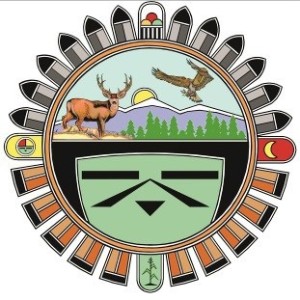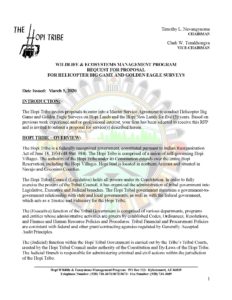The Wildlife & Ecosystems Management Program is in charge of management of the Wildlife and the Ecosystems, which includes the Woodland/Forestry and Wetland Habitat on the Hopi Reservation.
 MISSION/FUNCTION
MISSION/FUNCTION
When the Hopi and all the other People emerged from the Sipaapuni into this, the Fourth World, we chose an ear of corn to represent our way of life. Instead of a large ear of corn, we chose the smallest ear of corn. This ear represented what the Sinom knew would be their enduring struggle for existence. However, Maasaw, the guardian of the Upper and Lower Worlds, gave us a gift: if we would migrate across Maasawtutskwa in the four directions, then Maasawtutskwa would become Hopitutskwa (Hopi Land). Thus we formed a scared covenant with Maasaw to earn our land and to serve as its stewards. By completing our migrations, we fulfilled our first obligation to Maasaw: we left behind our footprints in the form of ruins, graves, ceremonial springs, trails, shrines, petroglyphs, and potsherds.
We must continue to fulfill our covenant with Maasaw by being worthy stewards for Hopitutskwa. We have reverence for all that is Hopi: the land, the sky, the rocks, the soil, the streams, the springs, the plants and the animals. The Sinom are a part of all living things that depend on each other for sustaining life. The rabbits, prairie dogs and other small animals eat the green plants. The eagle, coyote and fox eat the rabbits. We eat our corn and the animals that sustain us.
Each of us makes sacrifices that all may live in harmony. We make our sacrifices through the hard work of tilling our crops, performing our ceremonies, keeping our hearts pure, praying for moisture and aiding those that need our help.
We hold sacred obligation and responsibility to the plants and animals on our land. Being Hopi-Tewa means behaving properly. Our ancient traditions instruct us on how we should care for our children, the plants; and our brothers and sisters, the animals. When we hunt, we hunt with the knowledge that the animal has agreed to make a sacrifice for us. We must repay that sacrifice through our ritual and our offerings. If we do not do this, we have violated our covenant. It is our obligation, day by day, to conduct ourselves in a manner that shows our respect for the land and all it contains. It is our obligation, day by day, to protect the plants and animals that need our help.
In keeping with our Mission Statement, the Wildlife & Ecosystems Management Program provides various services, provides assistance and establishes management practices and goals to fulfill our mission for the benefit of the Hopi People and Lands.
The Hopi Wildlife & Ecosystems Management Program (WEMP) is divided between the Wildlife Management Unit and Ecosystems Management Unit. Each Management Unit has different responsibilities, goal and objectives, but share a common goal to meet our Mission and Function.
The WEMP goals and objectives follow the 2011 Hopi Pötskwanait, revised November 2011 and comply with Hopi Tribal Ordinances #47 (Woodlands) and #48 (Wildlife), Integrated Resource Management Plan (IRMP-Adopted May 2001), Integrated Woodlands Management Plan (Adopted 2006), and other related Tribal and Department of Natural Resources Plans, Policies and Ordinance.
Wildlife Management Unit:
- Hunting Regulations – Deer and Elk, and Furbearers
- Fishing Permits – Beaver Dam (Pond)
- Game Surveys – Big Game, Furbearers, Predatory and Non-Game Surveys
- Provide Hunter Education Classes
- Public Information and Education on Wildlife Management
Ecosystems Management Unit:
- Wood Permits – Commercial and Non-Commercial
- Monitor Woodlands areas
- Inventory of the Woodlands
- Wood Harvests – New Lands
- Provide Public Information and Education on Woodlands Habitat

